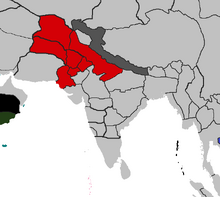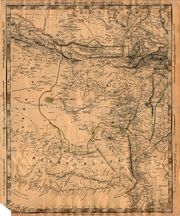| Timurid Empire of Kabulistan Pashto/Persian: کابلستان Timeline: Ninety-Five Theses (Map Game)
OTL equivalent: Kabul under Babur | |||||
|---|---|---|---|---|---|
|
|||||
| Capital (and largest city) | Kabul | ||||
| Official languages | Pashto, Farsi, Chagatai Turkic | ||||
| Ethnic groups | Afghan, Turkish, Persian | ||||
| Demonym | Timurid | ||||
| Government | Absolute Monarchy | ||||
| - | Padshah | Ẓahīr-ud-Dīn Muḥammad ( Babur) | |||
| - | Crown-Prince | Humayun | |||
| - | Religion | Sunni Islam | |||
| Significant Events | |||||
| - | Conquest of Kabul | 1504 | |||
| - | Defeat of Shaybani | 1510 | |||
| - | Conquest of Sistan | 1519 | |||
| - | Establishment of the Mughal Empire | 1526 | |||
The Timurid Empire of Kabulistan (Pashto/Persian: کابلستان) or more commonly Kabul was a collection of territories under the rule of the Central Asian conqueror Zahir-ud-Din Muhammad, known as Babur.
Following the loss of Samarkand and their ancestral homeland the remaining Timurids have collected under the Emperor or Padshah and with the assistance of the western Persians they have solidified their position in Afghanistan and the Hindu Kush following the defeat of the Shaybani. Babur has set his sights on a Hindustani empire and has since 1514 worked to reform his army and administration.
In 1519 Babur conquered the city of Haozdar and installed his Empire within its province. Following his victory he was proclaimed Mirza of Sistan. The province of Multan was, with the help of its own princely families was forcibly annexed in 1522. This conquest was the the first to bring into doubt the honour of the Padshah, yet the first step into the sub-continent.
Following a successful campaign against the Lodi Delhi Sultanate, Kabul acquired more than half of territories, and thanks to other conquests, allowed Babur to declare a true Empire of Gurkani, or more commonly, the Mughal Empire (Ninety-Five Theses).
History[]
Blood of Conquerors[]
The history of this fledging Empire and its founder, Babur are one and the same. Babur was born in Andijan in his father's domain of the Fergana Valley. Through his father Babur was a descendant of the mighty Timur (Tamurlane) and through his mother he claimed kinship with the Great Khan, Genghis. Ascending his father's throne in the Fergana Valley at only eleven could have been the beginning of a great epic, however Babur's early life was plagued with military loss and usurpation of his lands. Despite his young age Babur won his first campaign at 15 taking Samarkand yet with this victory came defeat as his throne of Fergana was usurped. En route home to reclaim Fergana there was an uprising within Samarkand and it was lost to a rival prince, Babur would spend from 1498 until 1502 attempting to reclaim both realms before resigning himself to other conquests.
Conquest of Kabul[]
Kabul had fallen into the hands of an infant of the Arghun Dynasty who was promptly usurped. The unpopular nature of the new ruler of Kabul led to the local populace resisting his stolen rule. Babur took the opportunity with both hands and marched his armies across the snowy Hindu Kush, seizing Kabul from the Arghun and claiming his own domain.
Persian Alliance[]
Babur's new Empire despite his new conquests and vast swathes of territory was still threatened by enemies in his past, namely the Uzbek Shaybani. Attempting to rally the only other Timurid ruler left, Sultan Husayn Mirza Bayqara of Herat, Babur hoped to repel their dreaded foe. Fate was against the Timurids as Husayn died, leaving Herat to two craven sons who refused Babur's call to arms. Herat was overrun by Shaybani shortly after and the Mirzas were forced into exile.
As a result of the exile of the Mirzas there was only one Timurid ruler left with a domain of his own, Babur. Due to his acceptance of the many princes and displaced people of the former Timurid realms they proclaimed him Padshah (emperor). Shaybani was put to death after his defeat by Ismail I, Shah of Shia Safavid Persia in 1510 leaving free reign to attempt to reclaim his ancestral homelands. The campaign with the Persians, to whom Babur recognised as his suzerain led to some victory and again some defeat. In 1514 Babur returned to Kabul determined to reform his army, his administration and most importantly his own position.

Babur setting off to Sistan, 1519
Sistan War[]
After being denied lordship over the lesser tribals of Sistan, Babur assembled 15,000 men and marched into the province, laying siege to Haozdar. Babur once again sent a demand of subjugation, but the Sista stood their ground. The siege was a slaughter befitting a son of Genghis, after the city fell Babur executed the city governors for their defiance yet then distributed help to the poor villages of Sistan. Freedom of religion was renewed within the Empire during this period which peeked the curiosity of the Indian princes across the Kush.
From Coast to Mountain[]
Coming soon...
Timurid to Mughal[]
Coming soon...
Military[]
Artillery[]
Babur invested heavily in the development and acquisition of firearms for his army, revolutionising the East's relationship with warfare. With Ottoman assistance, Babur's bronze cannons, despite only firing twelve times a day, could launch a projectile over a mile. The small number of troops under Babur's command are more than capable of tackling foes three times their numbers. Alongside the Ottoman and Safavid Empires, Babur would be remembered as ruling a 'Gunpowder Empire'.
Army[]
Babur commands an estimated force of 17,000 soldiers, a mixture of horse cavalry, horse archers, foot soldiers and field artillery attendants. Babur's tactical command allows the use of smaller numbers and greater strategy to bring foes twice their strength to their knees.
Government[]

Kabulistan at the time of the Mughhal Empire formation. (1526)
Padshah[]
The Timurid Empire is led absolutely by the Padshah, Zahir-ud-Din Muhammad, or Babur. His authority, like his ancestors' authority is derived from tribal loyalties and control of his armies. Descendant on both sides from great Mongol traditions yet washed in Persian influence the realm has traits of both Western and Eastern monarchies. The Padshah appointed various governors for the major settlements of the realm, usually close family or loyal generals.
Babur has four sons; Humayun, Kamran Mirza, Askari Mirza and Hindal Mirza, while none are in their majority, Humayun has taken on minor ceremonial roles associated with a prince, and more importantly an heir.
Relations to the Tribal Chieftains[]
Babur's greatest opposition in Kabulistan was the tribal chieftains who sought independence and prestige for themselves, despite their rebellions Babur with his large retinue were never under any real danger. Babur incorporated the chieftains after the rising was quelled and even allowed them to assist in raids across the Khyber Pass.
Freedom of Worship[]
Unlike most conquerors Babur, like his mongol forefathers did not impose his religion on those he came to rule over. It is noted by many that the promise of freedom from religious uncertainty helped to sway the many Indian princes who sided in favour of Babur's conquest.
Culture[]

Realm of Kabulistan
Kabulistan under Babur was a refuge for the remaining Timurid people who as Mongol descendants were tempered with a dozen cultures and beliefs. Despite being Sunni and speaking Chagatai Turkic, Babur welcomed Persian and Turkish influences while embracing his heritage. A great believer in both conquest and art his court was littered with poets, painters and builders ready to spread their influence.
| |||||||||||||||||||||||||||||||||




